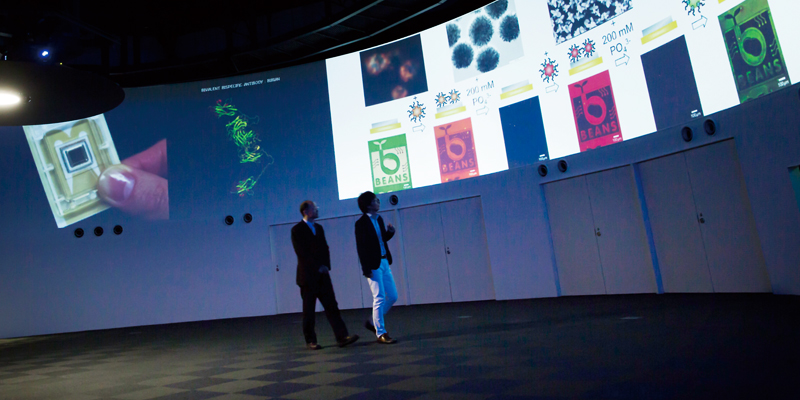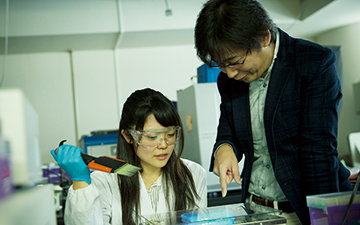
Organically Speaking: Life Science and Engineering
Living beings are made up of materials, conventionally organic chemicals. For example, in explaining to nonbiologists and those unfamiliar with genetics in a very roughshod manner – “clemency” requested herewith – the basic building blocks of a living body are based on deoxyribonucleic acids (DNA), a set of biopolymer strands in a double-helix form made up of certain types of amino acids and a sugar known as deoxyribose, the namesake item.
Such DNA is found “packaged” in a unit called the chromosome; as with the abovementioned “genome” these “ome” words can be thought as “package” (and the study of those touting “-ome” at the end are referred to by “-omics” as in “genomics” or “proteomics”). Proteins and cells are derived from amino acids as transcribed by ribonucleic acids carrying genetic codes as based upon the DNA.
When put together as a system, unicellular and higher living units become realized. Thus, life science is of interest as human beings are also living units, and upon attempting to gain a good “Quality Of Life” for themselves, people are seeking for ways to manipulate materials to improve their lot. These days, the ability to discern and alter materials at the nanometer level has led to protein engineering, among other types of nano-level engineering.
Think Big, Design Small
− Prof. Hitoshi Shiku, Systems Specialist, and Prof. Mitsuo Umetsu, Design Expert
Dr. Shiku: I am by training an electrochemist who looks – both figuratively and literally – at things from the systems perspective. I believe I can observe and handle systems at the microscopic frontline, while retaining the overall view from a systematic standpoint. I suppose I took in a global vista, garnering a wider view by having spent time overseas at Department of Chemistry, the University of Kansas for post-doc work.
Dr. Umetsu: In contrast then I'm an expert as to design at the nanometer order, handling amino acids, proteins and peptides, having been involved in the pharma field, covering from drug design to delivery. Being part of the biomedical engineering thrust at Tohoku University, I've handled in-vitro (“wet”) activities in addition to “dry” data-driven efforts.
The Name Of The Game - Hybridization and Variety
Dr. Shiku: Although our operational bases are in close proximity to one another, it may be said that it could be better to have a third party assist in linking up the two research efforts in a more “organic” manner. This is because we both need to concentrate thoroughly on research fronts due to the competitive nature for our fields of choice.
Dr. Umetsu: Regarding hybridization, with the design at a grander scale to be implemented with proper fusion at the component level (organic bases needing integration into inorganic parts, such as cell surfaces being melded into metallic electrodes), a “bridger”... analogous to a bee assisting with cross-pollinations.. may be quite useful. And I like bees – especially their hives made up of hexagonal “cells”... quite symbolic.
Dr. Shiku: Yes, we could expect even more “variety” when it comes to Research & Development, should manufacturers or other business entities come to contribute to the work schemes, as it is quite variety ladened though. It would be intriguing to guess the outcome as to exactly how issues like relationships with industry and government sectors will be dealt with under such a set-up.
Dr. Umetsu: Indeed, such a third party might help us to work even more closely. Biodiversity is important in the environmental sciences and variety, to engineering.
The Big Picture
Dr. Shiku: Now, for interesting activities you were involved in that I'm aware of, there was the Bio Electromechanical Autonomous Nano Systems (BEANS) project run by the Micromachine Center and backed by Ministry of Economy, Trade and Industry-affiliated New Energy & Industrial Technology Development Organization (NEDO). Concluded several years ago, I believe BEANS produced many results related to Micro-Electro-Mechanical Systems (MEMS) and microfluidics, as represented by small “cells on chips” among other manifestations that are linked to my research too. The leader of this effort I remember was known for growing a human ear on the back of a mouse, a sensational way to catch the eye!
Dr. Umetsu: Indeed. By the way, I heard that NEDO began expanding into life science-related activities due to biomass and associated research. It should be noted that after all, even at the cellular level there is energy being produced by the mitochondria.
Dr. Shiku: Quite right. Without fuel, or in living organisms' case, foodstuff, the “system” obviously cannot be sustained so I think you may be correct. As to why they named the project BEANS, I can but only guess but possibly had something to do with Jack and the beanstalk. Maybe was trying to take in the “big picture” from above, the bird's-eye-viewpoint. Speaking of naming, can you tell us about BIBIAN?
'BIBIAN'
Dr. Umetsu: As to my past work, I have been involved in producing antibodies as part of a “smart unit” to defeat cancer and combat diseases, aiming for better selectivity of such treatment agents. In this vein, I prepared a bispecific and bivalent antibody which I called 'BIBIAN'... named in a nod to a versatile TV personality from Taiwan. She was popular in Japan some years back.
Dr. Shiku: I see, BIBIAN is an acronym for “Bispecific and Bivalent Antibody”! Ingenious!
Dr. Umetsu: Thank you! I even considered using “Smart Unit” after it but I thought that would have been a tad too much.
Dr. Shiku: You are also involved in drug design. Can you elaborate further on this for our readers' benefit?
Dr. Umetsu: Considering the rapidly-greying society, in particular in Japan, I was looking to improve the situation faced by those suffering from kidney disorders, and I searched for means to “revitalize” remaining normal renal cells. Just as with prospects of human kidneys being grown in pigs thanks to genetic engineering, there is the outlook for design allowing stem cells to be grown into full-sized kidneys.


